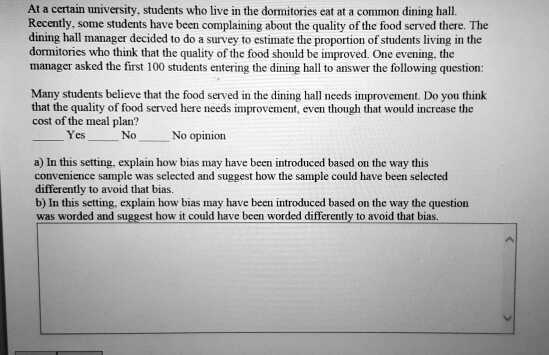
Solution:
a)
The fact that he surveyed people 'entering the dining hall' introducing selection bias.
How about those student just don't bother considering the dining hall? They must have been fed up with the bad food quality!
Pick student with prime student number might work much better, this is more or less simple random sampling.
b)
The fact that the question implies a cost increase introducing bias.
I would worry the price would increase too if I say the food is not good and improved.
That fact that I can only answer yes or not introducing bias.
If I were a student and I think the quality is a little bad but fine, I have no way to express that.
The fact that the manager is asking is introducing response bias.
If I were a student, I would not say the quality of the food is bad to dismay the boss (I would worry if he will serve me bad food moving forward)
The fact that there is 1 common dining hall is introducing bias.
Without comparison it can be hard to tell food quality.
It can be done through an anonymous survey, the question should look like this:
In rating 1 - 10, what do you think is the quality of the food in the dining hall?
In rating 1 - 10, what do you think is the quality of the food in the Mcdonald?
In rating 1 - 10, what do you think is the quality of the food in the XXX (Some other competitor) ?
A few design points here:
- By staying anonymous, student can feel free responding without worry retaliation.
- By comparing, researcher can make sense out of the relative scale.
- By having many rating, student can now choose, something like 3 - 7 to indicating slightly like/dislike instead of just yes or no.
No comments:
Post a Comment